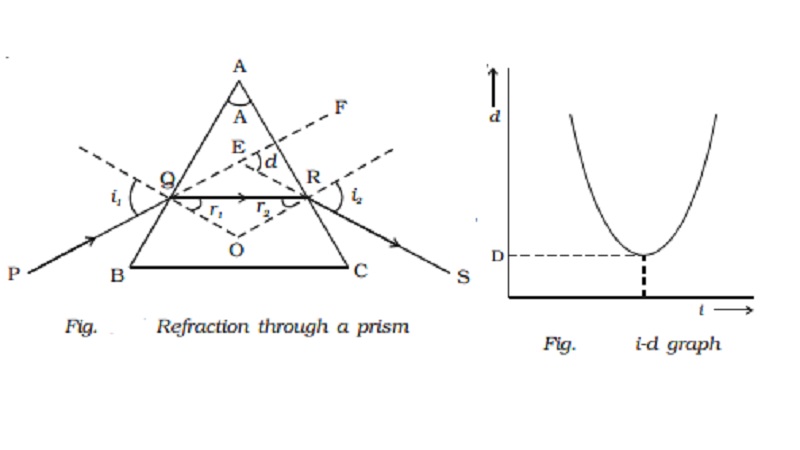Chapter: 11th 12th std standard Class Physics sciense Higher secondary school College Notes
Refraction of light through a prism

Prism
A prism is a
transparent medium bounded by the three plane faces. Out of the three faces,
one is grounded and the other two are polished. The polished faces are called
refracting faces. The angle between the refracting faces is called angle of
prism, or the refracting angle. The third face is called base of the prism.
Refraction of light
through a prism
Fig. shows the cross section of a triangular prism ABC, placed in air. Let ?A? be the refracting angle of the prism. A ray of light PQ incident on the refracting face AB, gets refracted along QR and emerges along RS. The angle of incidence and refraction at the two faces are i1, r1 , r2 and i2 respectively. The angle between the incident ray PQ and the emergent ray RS is called angle of deviation, d. In the ∆QER, the exterior angle FER = angle EQR + angle ERQ
d = (i1 - r1) + (i2 - r2)
d = (i1 + i2)
- (r1 + r2)
????.(1)

In the quadrilateral AQOR, the angles at Q and R are right angles
Angle Q + Angle R =
1800
A + Angle R = 1800 ????.(2)
Also, from the ∆QOR
r1+ r2 = A ??????..(4)
Substituting in (1),
d = i1 + i2 - A
or A + d = i1 + i2 ...(5)
For a given prism and for a light of given wavelength, the angle
of deviation depends upon the angle of incidence.
As the angle of incidence i gradually increases, the angle of
deviation d decreases, reaches a minimum value D and then
increases. D is called the angle of minimum deviation. It will
be seen from the graph (Fig. ) that there is only one angle of
incidence for which the deviation is a minimum.
At minimum deviation position the incident ray and emergent ray
are symmetric with respect to the base of the prism. (i.e)the refracted ray QR
is parallel to the base of the prism.
At the minimum deviation
i1 = i2
= i and r1 = r2
= r
from equation (4) 2r = A or r = A/2
and from equation (5) 2i = A + D or i = ( A+D )/2
The refractive index is ? = sin i/sin r
? = [sin((A+D) / 2)] / sin(A/2)
Related Topics